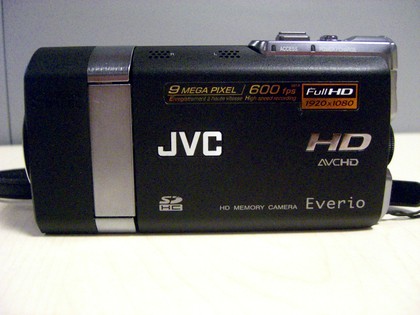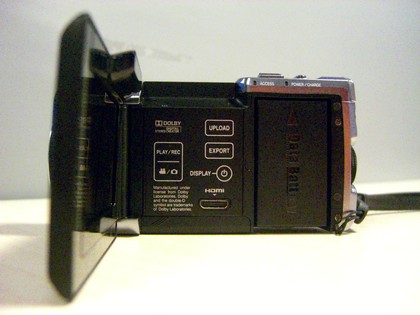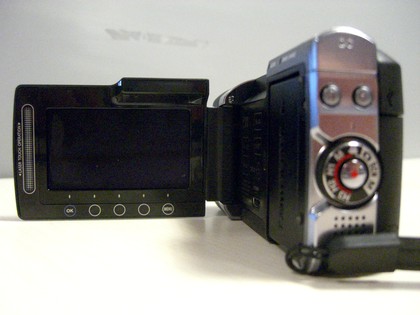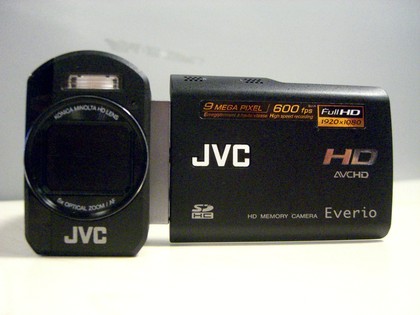Hands on: JVC Everio GZ-X900 review
First impressions of JVC's Full HD compact camcorder
Full HD camcorders have come a long way in a short space of time. Whereas a mere year ago, if you wanted a 1080p shooter, you would have to expect a bit of bulk to go with it, JVC's latest Everio offering is as slim as they come.
TechRadar were lucky enough to be among the first journalists in the UK to get a hands-on with the camcorder.
First impressions are that the cam is a rather odd shape, long and thin and quite unlike any other camcorder on the market. Saying that it feels comfortable to hold; your thumb is perfectly positioned on the record button, with your index finger slotting on top of the still image button and your middle finger ready to use the zoom.
Although the X900 is solid in the hand, as it uses SD cards to record footage (one hour's footage equals 4GB), there's very little weight to it. Couple this with a rather flimsy hand-strap and you'll be wanting to grip the camcorder that little bit tighter when shooting footage.

JVC has opted for simplicity with its new camcorder. The matte-black chassis is unassuming with a mode dial sitting neatly on the back, with all connections out of sight. Even the battery is nowhere to be seen, as it's because it has been integrated into the body, but flip open the LCD monitor and there it is.
While this is a fantastic idea by JVC to hide the ugliest, bulkiest part of any camcorder, it is a gamble. The battery is proprietary, which means that current JVC users will not be able to use their old batteries and will have to fork out around £70 if they want to carry round a separate spare power box.
And most will want to as this is a power-hungry machine, draining the battery in just over an hour.
Get daily insight, inspiration and deals in your inbox
Sign up for breaking news, reviews, opinion, top tech deals, and more.
Next to the battery on the inside of the machine are various options: Play/Rec, Upload, Export and Display. Underneath this is a mini-HDMI slot.

The flip-out LCD screen looks quite chunky. There's a thick frame around the flip-out 2.8-inch screen that's unfortunately not touchscreen with JVC opting instead for a Laser Touch strip lighting up nicely when pressed and stroked.
There are four Laser Touch buttons on the bottom of the screen, which are fine to use if your fingers are slim. A chunky digit may find navigation a bit of a fumble.
When it comes to shooting footage, the X900 shines. We saw footage recorded from the camcorder displayed on one of JVC's high-end LCD TVs and colours were vibrant. Edges around things like buildings were sharp and there was real depth to the images.
This has something to do with JVC adding a whopping 10.3MP CMOS sensor into what is a diminutive camcorder – a world's first.
This also means that still shooting has also vastly improved. In fact, JVC are touting this camera as some sort of camcorder/camera hybrid, with the boast that the camera can take 9MP stills without any interpolation.

The back menu dial is even split 50/50 between camcorder controls and camera ones. Don't expect any manual controls on the camera side, though. The X900 deals strictly in Scene modes, such as Food and Sleeping Child. That's right, you can now take pictures of your sleeping child, safe in the knowledge that you won't wake them with a pesky flash or camera sound. Strange.
Surprisingly, there are no scene modes for video, with the X900 putting you in control of how you approach your moving subjects.

In the short time TechRadar has had with the camcorder, the JVC X900 has impressed us.
There are a number of niggles (there's no mic input, no headphone output, no accessory shoe) but for those who want a compact camcorder that shoots stunning Full HD footage, and have a spare £899 lying around, then the X900 is definitely one to consider.
Marc Chacksfield is the Editor In Chief, Shortlist.com at DC Thomson. He started out life as a movie writer for numerous (now defunct) magazines and soon found himself online - editing a gaggle of gadget sites, including TechRadar, Digital Camera World and Tom's Guide UK. At Shortlist you'll find him mostly writing about movies and tech, so no change there then.
